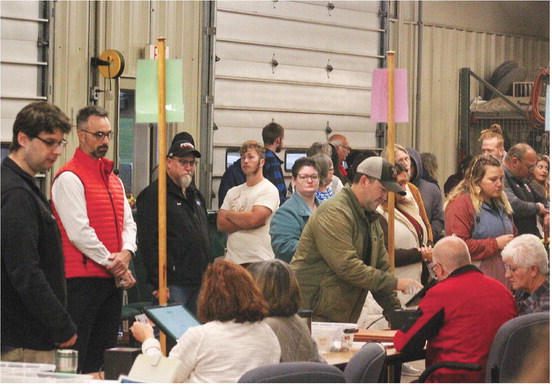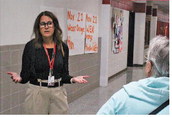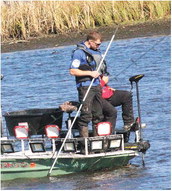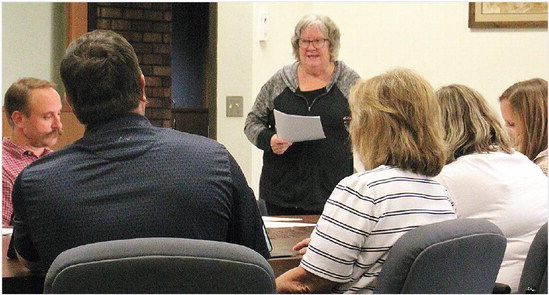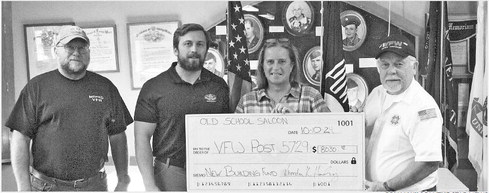Team to study school consolidation
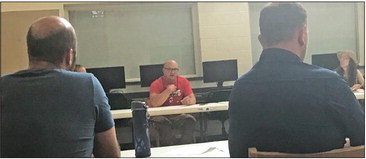

A team of 22 people — 11 each from the Abbotsford and Colby school districts — will study the possibility of consolidation and present their findings to local school boards midway through next year.
That was the main decision that came out of a joint meeting of the Abbotsford and Colby school boards last Tuesday, July 27, at Colby Middle School. Members of the two boards and each district’s superintendent spent about 90 minutes discussing what the next steps will be in exploring possible consolidation.
Each school board will appoint two parents, two teachers, two community members, two school board members, one support staff and one student to the consolidation study team. The two superintendents will round out the team’s membership.
The pairs of teachers and parents will be split so that one represents pre-kindergarten through sixth grade, and the other represents seventh through 12th. A high school freshman or sophomore will be sought to sit on the team since a possible merger would affect them.
Last week’s meeting was in response to an advisory referendum held during the April 6 election, which showed a majority of local voters in favor of researching school district consolidation.
Another referendum would still be needed if the two districts were to proceed with merging their operations, and both school boards would also need to sign off on the action.
Going forward, the next step is for each school board to decide at their Aug. 16 meetings how to recruit members for the team, with the goal of appointing the members at their Sept. 20 meetings.
Colby Superintendent Steve Kolden said it will be up to the members of each school board to decide how to pick their district’s representatives.
“We’re respecting the uniqueness of each board, and how you pick yours may be different than how we pick ours,” Kolden told Abbotsford board members.
Administrators will also present their respective boards with a cost estimate for studying consolidation at their Aug. 16 board meetings, giving elected officials a chance to set a budget for the process.
The districts are looking at hiring School Perceptions, a firm that specializes in preparing school districts for referendums through the use of community surveys and other data-gathering tools.
Kolden estimated that it would cost between $4,000 and $5,000 for School Perceptions to assist the districts in exploring the consolidation idea.
Baird, a financial consulting firm, is also being contacted to provide budgetary projections for a consolidated school district, including the potential impacts on property tax rates.
The Wisconsin Association of School Boards (WASB) will also be consulted for free advice on school consolidations.
Kolden noted that Al Brown, the former superintendent of the Chetek School District, would be a great resource since he was the administrator when Chetek merged with Weyerhauser.
When Abbotsford board member Eric Reis asked about having a single consultant to guide the process, Kolden said Brown may be the best choice.
Everyone who spoke at last week’s meeting emphasized the need to find out what community members think about consolidation and what questions they want answered before the two districts move forward with the idea.
“If I’m 62 years old and I have no kids in the district, I’m more concerned about what this is going to do to my tax rate,” Kolden said. “If I have a third-grader, what is it going to look like when they hit middle school and high school?”
Abbotsford board member Eric Brodhagen said the success or failure of the consolidation idea will likely come down to dollars and cents.
“If it doesn’t make financial sense, in my opinion, it’s never going to happen,” he said.
Another factor that generated a lot of conversation was the location of the high school in the new district — or whether two high schools could be maintained.
Kolden pointed to Wausau and Eau Claire as school districts that operate two separate high schools.
“You can consolidate districts, leave two high schools and not change a lot,” he said.
One larger high school would come with many academic benefits, he said, allowing the hiring of more teachers to offer higher level math and science courses. At the same time, opportunities in athletics may become more scarce.
“If you have one high school, you have five basketball starters,” he said. “If you have two high schools, you have 10 basketball starters.” Keeping two high schools would also diffuse the tension of students having to give up their traditional identities as either Hornets or Falcons, Kolden said.
Brodhagen, however, wondered if this was a realistic idea, especially when it comes to financial matters.
“Now we’re talking two high schools in two different municipalities with one budget,” he said.
Regardless of which option is decided, Kolden said it will be an important one to consider.
“High school location will come up as something the community wants to know,” he said.
Staffing, especially at the administrative level, was another hot-button topic identified by board members.
“Will we need to let people go?” asked Colby board member Cheryl Ploeckelman.
Abbotsford Superintendent Ryan Bargender, who was recently promoted to his position from high school principal, said a consolidation will likely create “a lot of overlap.”
The situation is complicated by the fact that Kolden plans on retiring at the end of the 2022-2023 school year.
Based on a timeline established at last week’s meeting, the study team will present the school boards with a progress report in May of 2022, letting them know if they are ready to present a final report by August of that year.
Once the team presents all of the information it gathers, the school boards would need to vote at their August 2022 meetings if they wanted to get a question on the November 2022 ballot. This would coincide with midterm elections for Congress and ideally drive up turnout.
Depending on the results of that election (assuming one is held), the consolidation process could be in full motion by the time Kolden left. At that point, Colby would have to decide whether to hire a replacement for one year or start sharing a superintendent with Abbotsford.
Ultimately, the two boards said it will be up to the study team to answer these questions over the course of roughly a year. At the same time, team members will need to do community outreach to find out what parents, teachers, and members of the public want to know about the prospect of consolidation.
“I think one of the early questions is: ‘What other questions do you want answered?’” Kolden said.
‘A waste of time’?
Kraig Schindler, a member of the Abbotsford School Board, repeatedly questioned whether the whole study team process was worth the effort at this point, based solely on results from April’s advisory referendum.
“Are we confident that this is something the community indeed wants?” he asked.
Two-thirds of those who voted on the referendum question cast their ballots in favor of studying consolidation further, but turnout was significantly lower than last November’s election, which featured the highly contested presidential race.
The April 6 results showed that only 402 residents in the entire Abbotsford School District voted in the referendum, along with 761 in the Colby School District. By comparison, 787 people in just the city of Abbotsford alone voted for president in the fall 2020 election.
Of those who voted, 247 residents in the Abbotsford School District were in favor (61%) of further study, compared to 528 (70%) in the Colby School District.
Schindler said more needs to be done to find out if parents and staff members actually want to move forward with consolidation talks. He suggested that surveys be sent directly to these groups of people so the school boards know if they are on the right track.
Ivone Vazquez, another member of the Abbotsford School Board, pointed out that Abbotsford has a large Hispanic population, and not all of them are allowed to vote — even though the issues directly affect their children.
“If they cannot vote, then how can they say what they think?” she said. “Maybe we should come up with a different way for everyone to be able to vote.”
Melissa Pilgrim, the new principal of Abbotsford Middle/Senior High, said she has previous experience working with School Perceptions, and they should be able to offer bilingual surveys to parents.
“They’re very accurate when they get
the results back to you,” she said. “Of course, it costs money.”
Still, Schindler was not satisfied with the amount of data the districts have at this point in the process. He said this all started with a discussion in January about possibly sharing a superintendent and it quickly accelerated to the point of talking about a full consolidation.
“I still want to know, before we spend taxpayer money, do both communities want us to entertain this?” he said.
Eric Elmhorst, a member of the Colby School Board, said he believes the referendum results are adequate evidence to suggest that enough people want the consolidation idea to be explored further.
“In my opinion, that field’s been plowed,” he said. “That is why we had that vote.”
Gary Gunderson, principal of Abbotsford Elementary, reminded everyone that April’s referendum only gave the districts a green light to study the possibility of consolidation, which is not a foregone conclusion at this point.
“I think we’re kind of jumping ahead and assuming there is going to be a final vote,” he said. “Isn’t this study supposed to gather all of this information for us to decide?”
